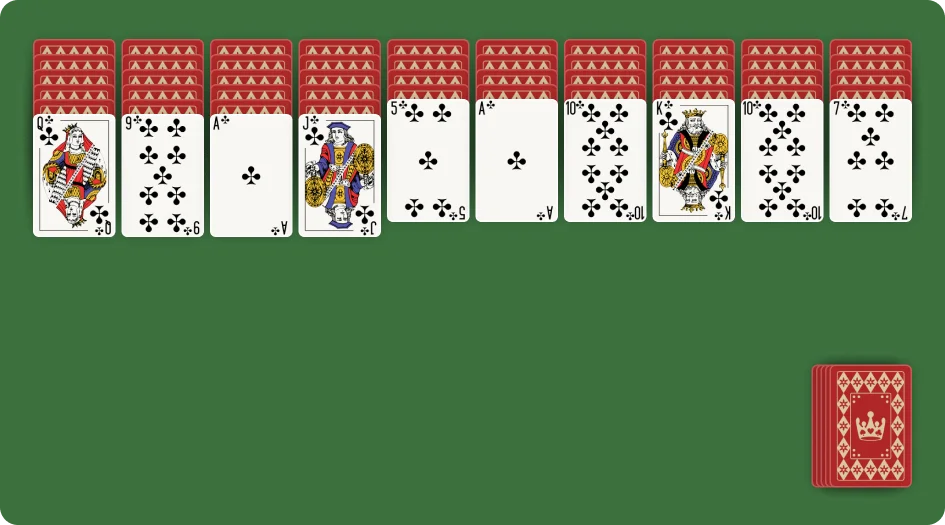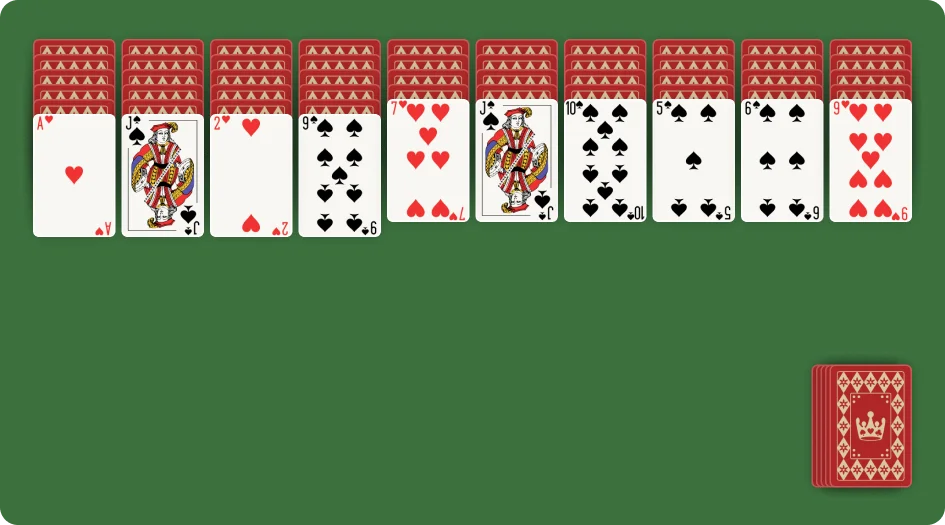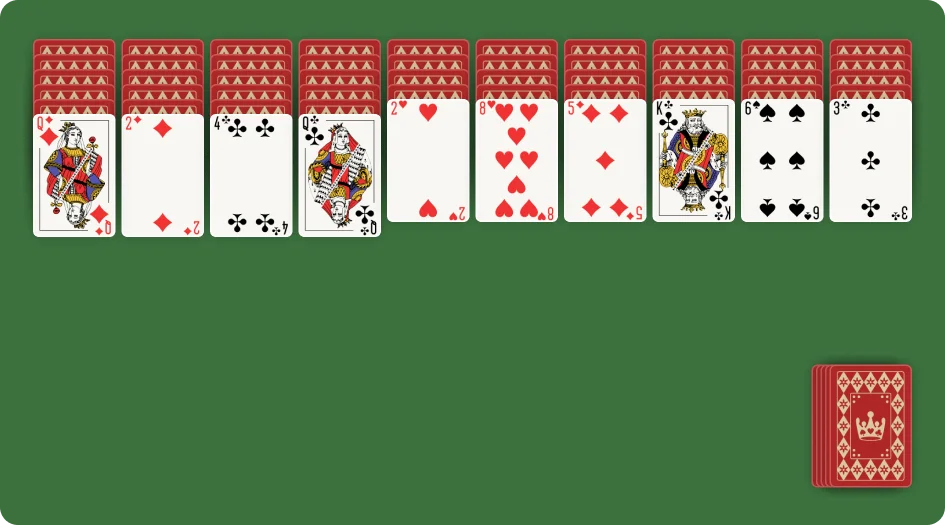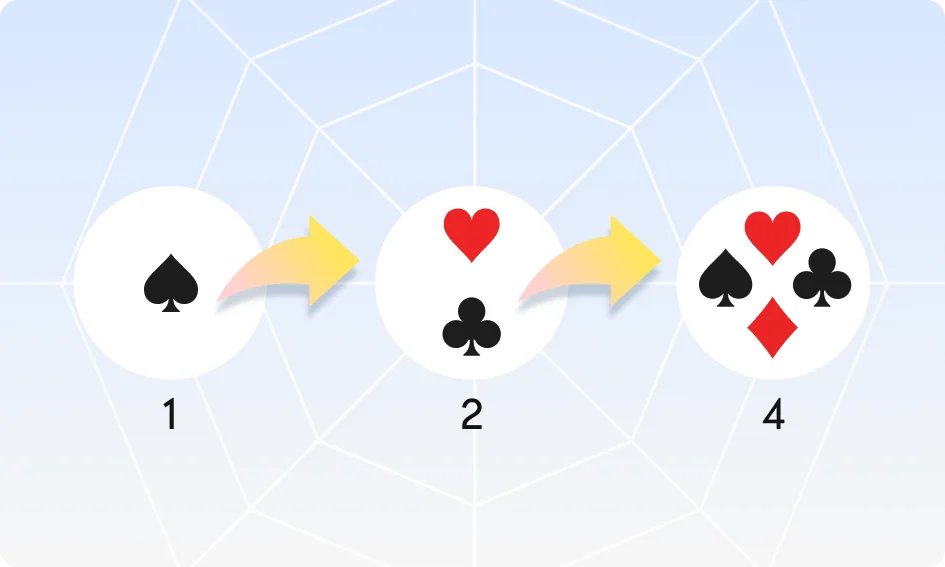When I started out playing Spider Solitaire, I quickly discovered that the game doesn’t just represent a single, static challenge. It involves a whole spectrum of challenges.
As you might already know, the game of Spider Solitaire typically comes in three flavors. Each offers a progressively more difficult challenge: 1 Suit (easy), 2 Suits (medium), and 4 Suits (hard). During my Solitaire journey, one of the most difficult challenges has been transitioning from 1 Suit to 4 Suits Spider Solitaire. While this transition can be exciting, it isn’t achieved easily. It really tests your skills (even as it adds to your gameplay experience).
Speaking from experience, there’s a lot to learn when you climb the Spider Solitaire ladder. So, whether you’re a seasoned player looking to master the game or a newcomer eager to learn, here’s a quick guide. This will help you improve your skills and eventually master 4 Suits Spider Solitaire – the goliath of the Solitaire world.
Starting with 1 Suit Spider Solitaire

Most players (including me) start with the most basic 1 Suit variant. 1 Suit is the perfect starting point for those who are new to this Solitaire niche.
In the 1 Suit version, all cards are from the same suit (typically Spades). This simplifies the game and makes it easier to implement basic rules and strategies. 1 Suit serves as the foundation for Spider Solitaire’s more advanced variants.
1 Suit introduced me to the game’s objectives. These include (a) creating sequences of cards in descending order from King to Ace and (b) clearing the tableau by moving these sequences to the foundations. Cracking 1 Suit Spider Solitaire only involves basic strategy, but it’s great for laying the foundation. You can then extrapolate the applicable strategy to the more advanced variants.
Key Strategies for Winning at 1 Suit Spider Solitaire
As mentioned, the strategy for winning 1 Suit Spider Solitaire is quite basic. Here are a few pointers that helped me master it:
- Focus on rearranging the cards to form complete sequences. You can use empty tableau columns strategically to rearrange cards, which helps you complete sequences.
- Try to reveal face-down cards as soon as possible. This gives you more movement and strategy options as you progress through the game. Flexibility is one of the most crucial elements to winning a game of 1 Suit.
- Even if you can’t complete them immediately, work on building partial sequences in descending order. This makes it easier to manage the tableau and prepare for future moves.
- Be willing to use the undo feature if necessary. It allows you to backtrack and explore different strategies if you find yourself stuck.
- Try to make as many moves on the tableau as possible before drawing additional cards from the stock. This avoids the complexity involved in managing new cards.
It’s alright if you struggle to implement these strategies in the beginning. It took me a good while to fully grasp them myself. Just make sure that you put in those practice hours, and you’ll be good to go.
Transitioning to 2 Suits Spider Solitaire

The second step of my Spider Solitaire journey involved engaging with the 2 Suits variant. 2 Suits introduces a new layer of complexity because, instead of dealing with a single suit, you now have to manage two suits (typically Spades and Hearts).
You can imagine how much this change can impact your strategy because you can only build sequences with cards of the same suit. This means that you need to pay even closer attention to suit-matching and the cards’ numerical order.
How to Adjust Your Strategy From 1 Suit to 2 Suits
There are a couple of things that helped me transition from 1 Suit to 2 Suits. Here are some pointers that can aid your journey:
- In 1 Suit, the focus is primarily on numerical order. In 2 Suits, you must prioritize suit consistency within sequences. This requires a more careful approach to moving cards and planning sequences.
- Empty tableau columns become even more valuable. Use them wisely to rearrange cards and free up those that are blocked. Remember, only Kings or sequences starting with a King can be placed in empty spots.
- Try to maintain a balance in your approach to both suits. Neglecting one suit can limit your options and make it more challenging to clear the tableau later in the game.
- With the added complexity of a second suit, it’s even more important to think several moves ahead. Consider the consequences of each move. This does not only apply to your immediate play but also your ability to form sequences in the future.
Common Pitfalls in 2 Suit Solitaire
Some habits from 1 Suit are bound to show up when you’re involved in a 2 Suits game. Try to remain cognizant of the differences between the two games, even if much of what you learned playing the former will help with the latter.
Use the undo button when you slip up, at least until you’ve mastered these pointers:
- A common mistake is to build sequences without paying attention to suit consistency, which can block your progress. Try to build sequences with the same suit. This avoids the creation of unmovable stacks.
- Focusing too much on one suit can lead to a shortage of moves. Keep an eye on both suits to ensure that you’re not cornering yourself.
- It might be tempting to fill empty tableau columns as soon as they become available. It can, however, be strategically advantageous to leave them open for more significant moves, especially when it comes to rearranging larger sequences.
- While the undo feature is helpful, relying on it too much can prevent you from learning from your mistakes and improving your strategic foresight.
Mastering 4 Suits Spider Solitaire

We can now move on to the ultimate challenge of 4 Suit Spider Solitaire. For the most part, 4 Suits applies the same concepts you used in 2 Suits. They’re both multi-suit variations and use the same rules and structure. However, having all four suits in play drastically increases the complexity and requires a deep understanding of the game’s mechanics.
When you introduce multiple suits, you don’t just complicate the sequence arrangement but also significantly reduce the chances of so-called ‘straightforward’ moves. So, you’re forced to employ a much more nuanced approach in every decision.
Nonetheless, advanced strategies in 4 Suits Spider Solitaire build on lessons learned playing the 2 Suits version. In either case, you need to be efficient in managing multiple suits. Don’t just focus on immediate moves. Rather, try to develop an intuition for potential sequence formations across different suits. The essence of 4 Suits is recognizing the interconnectedness of moves and how a single action can ripple across the entire tableau.
| Variation | Complexity | Suit management | Strategic depth | Win probability | Skill level |
| 1 Suit | Low | Single suit – Easier to form sequences. | Basic strategic planning. | High | Beginner |
| 2 Suit | Medium | Two Suits – Increased difficulty in forming sequences. | Advanced planning while considering two suits. | Moderate | Intermediate |
| 4 Suit | High | Four Suits – Highest difficulty; careful management required. | Highly advanced strategy and foresight required. | Low | Expert |
Closing Remarks
Getting to grips with 4 Suit Spider Solitaire is a rather daunting task. You can, however, make steady progress by climbing the ladder step by step. If you follow the pointers I’ve provided here, then you should be able to ultimately master one of the most difficult solitaire variants out there.






